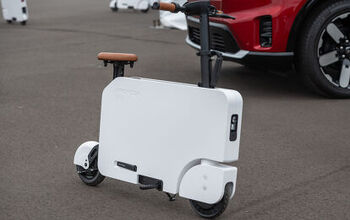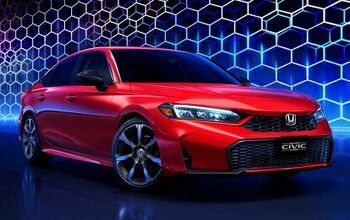Capsule Review: 2014 Range Rover Sport
“I could have had a V8!” was the tagline for a foul tonic of liquified vegetables and spices sold by Campbell’s, but also a metaphor for the deadly automotive sin of purchasing a V6 muscle car. In my own lifetime, I remember when anyone with a Y chromosome that willingly purchased a 6-cylinder pony car was derided as a skinflint at best, effete at worst. It wasn’t until the second decade of the 2000’s that things changed. The V6s on offer suddenly became legitimate options for ponycar buyers.
The V6 Mustang was no longer a secretary special, but a legitimate sports car, offering comparable straight line performance with the old Mod Motor Mustangs, and able to dispatch its import competition around a road course. The GM HFX V6 and Chrysler Pentastar V6s went a long way to raise the game of the rental-spec Camaros and LX/LY chassis cars respectively, making it hard for us to imagine that the old 2.7 Chrysler V6 and the GM 3.9L ever existed. That doesn’t mean that you should willingly opt for two less cylinders. Not in a pony car. But in a Range Rover Sport, it wouldn’t be the worst thing.
If not for some scheduling screw-ups, I would have only driven the car you see above, a Range Rover Sport Supercharged model finished in the kind of discrete shade of grey typically favored by buyers of these cars. Since my parking spot is on the 6th floor of an underground garage, I had to have my condo’s concierge spot me as I made my way down the ramps (with the adjustable air suspension set to “Access” mode, which lowers the ride height), as I sweated bullets while trying to avoid contact with the garage’s giant air ducts, fearful that I’d have to explain the enormous scratches on the roof of the Rover.
Before I moved in, I had the big boy Range Rover Supercharged, and came off less than impressed. The prior-generation Range Rover was once the superior vehicle, with the LR4-based Range Sport a dreadful, cut-rate alternative, with awful dynamics and an unfortunate association with fans of Tapout clothing. Not so anymore. The full-size Rover, the Official State Vehicle of the Kardashian Republic of Calabasis, takes a back seat to the Sport. The new baby Range is bloody brilliant. It makes the big one redundant.
My intial impression was only confirmed by my stint in the V6, which came a few weeks after my time in the V8. After my scheduled press car was pulled, I was given a consolation prize in the form of a Range Rover Sport in HSE trim, which comes with the 3.0L Supercharged V6 found in the Jaguar XJ and the “base” trim F-Type.
In typical driving scenarios, both V6 and V8 versions are functionally identical. While the full-size Range Rover has adopted a feel that would be traditionally ascribed to a large American sedan, the Sport has a character of its own. The numb steering and floaty ride of the big Range are nowhere to be found. Instead, the Sport is composed and even a little firm, without being harsh, while the steering has a heft and level of communication on par with the Jeep Grand Cherokee SRT. The quality of the interior materials is superb, with supple leather liberally appointed throughout the cabin, along with the aluminum accents and piano black trim that is currently en vogue in the premium segment. There’s very little noise, aside from what’s playing on the Meridian sound system. The infotainment system is easy to operate, with a big touch screen and a fairly intuitive menu. There are even arm rests for the front bucket seats, which were a hit with my passengers riding shotgun.
The absence of two cylinders in the HSE is only apparent when you step on it. The V6’s 340 horsepower comes on after a brief pause, while the Supercharged V8’s 510 ponies present themselves in a much more apparent fashion. Both have more than enough power, though the Supercharged version’s extra grunt can generate triple digit speeds in a much quicker manner. Shifts are handled by the ubiquitous ZF 8-speed automatic, which is civilized when left in “D”, and far more responsive when shifted into “S”.
The real tie-breaker between the two is the Supercharged model’s “Dynamic Mode”. Shift the Supercharged into Sport mode and adjust the console mounted rotary dial to the far left, and the Supercharged adopts a fight-or-flight like response: the stocks stiffen, the shifts quicken and the throttle mapping becomes markedly more aggressive.
The change in demeanor is startling. In Dynamic Mode, the Supercharged version feels like a very well appointed Cherokee SRT, lunging forward with a carnivorous intensity. You wouldn’t expect something this tall and bulky to handle so well, but like the SRT, it manages to challenge your perceptions of what an SUV is capable of. When you’re done flinging the two-and-a-half tonne aluminum bobseld along the piste, you can push the shifter back into drive, take it out of Dynamic Mode and get back on your way to the yoga studio.
Trying to achieve the same results in the HSE is far less gratifying, and not advisable. But at least the differences in capabilities are clearly demarcated. If you really want a something like a Grand Cherokee SRT or a Mercedes-Benz ML63 but suffer from an acute case of Anglophilia, spring for the $79,995 Supercharged. For everything else, including school runs, trips to Whole Foods and the yacht club, the HSE will suffice. You coulda had a V8, but you’ll save nearly $12,000 and have 98 percent of the capabilities of both the Supercharged, and a much better car than the $84,000 full-size Range Rover.
More by Derek Kreindler
Latest Car Reviews
Read moreLatest Product Reviews
Read moreRecent Comments
- Lou_BC “We are always listening to the customer. "You sayin' the baller/gangsta types don't want Escalades on 24's that don't make vroom vroom rumbly sounds?
- AZFelix I shall fully endorse the use of autonomous cars on public roads once they have successfully completed my proposed Turing test for self driving vehicles. This test requires the successful completion of an at fault incident and accident free 24/7 driving session in Buffalo and upstate New York from October 1st until March 31st, and throughout the city of Jakarta, Indonesia for one consecutive year. Only Level 1 and Level 5 vehicles are permissible.
- Lou_BC I'd go Rav4. No Mazda dealer in my town and from what I've seen, Mazda's tend to rust.
- Steve Jacobs I've got a bright Red Kia EV6. Easy to find in a parking lot.
- MKizzy Gently used EV6's under $30K aren't hard to find and have the range and style to almost intrigue me into taking the EV plunge. However, I'll wait for a mid-sized non-luxury EV sedan or wagon which is not a tablet housing a car (Model 3) or sacrifices too much usable space for the sake of style (Ioniq 6) before I go electric. I'm not holding my breath.



































Comments
Join the conversation
I want to rent this car so bad and set down tire tracks across the snowy mountains and valleys of Europe. I'd save money on hotels by sleeping in the back of this bad boy and showering with water bottles in the wilderness!
I really don't mean to be a d*ck, but: "The GM HFX V6 and Chrysler Pentastar V6s went a long way to raise the game of the rental-spec Camaros and LX/LY chassis cars respectively, making it hard for us to imagine that the old 2.7 Chrysler V6 and the GM 3.9L ever existed." 1. While it is hardly legendary, there is nothing wrong with the GM 3.9L V6 that should place it along with the infamous Chrysler 2.7L V6 in any discussion. 2. The Michigan Police test showed a 3.9L Impala 9C1 had the same acceleration figures as a Pentastar Charger. 3. The 3.9L V6 never went in any Camaro ever. Base Camaros used the 3800, which will still be running after every DOHC GM engine has died, been melted down, and been turned into F-150 body panels. The 3800 Camaro was also faster than the V6 Mustang of that era, something the current V6 Camaro can't say. 4. I'm not sure what "HFX" is. I think the code on the Camaro's engine is "LFX".